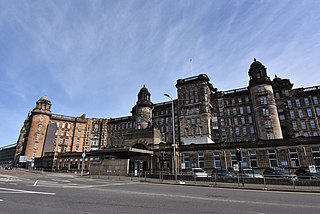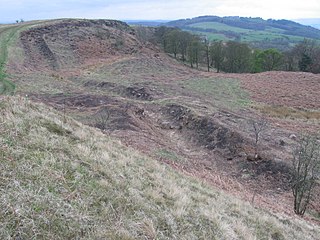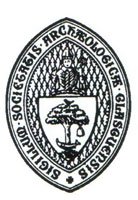
The Maeatae were a confederation of tribes that probably lived beyond the Antonine Wall in Roman Britain.

The Great Serpent Mound is a 1,348-foot-long (411 m), three-foot-high prehistoric effigy mound on a plateau of the Serpent Mound crater along Ohio Brush Creek in Adams County, Ohio. Maintained within a park by Ohio History Connection, it has been designated a National Historic Landmark by the United States Department of Interior. The Serpent Mound of Ohio was first reported from surveys by Ephraim Squier and Edwin Davis in their historic volume Ancient Monuments of the Mississippi Valley, published in 1848 by the newly founded Smithsonian Museum. The Serpent Mound is the largest serpent effigy in the world.

Summerston is a residential area of Glasgow, Scotland. With most of the housing constructed in the 1970s, it is situated in the far north of the city and is considered to be part of the larger Maryhill district, but has a different postcode; other nearby neighbourhoods are Gilshochill to the south and Cadder to the south-east. With open farmland to the north-east, Summerston is separated from the southern parts of the town of Bearsden to the north-west by the River Kelvin and a golf course.

Old Kilpatrick, is a village in West Dunbartonshire, Scotland. It has an estimated population of 4,820. It belonged to the parish of Old Kilpatrick which itself was only a few thousand people strong.

Cadder Not to be confused with the Glasgow area of a similar name, is a district of the town of Bishopbriggs, East Dunbartonshire, Scotland. It is located 7 km north of Glasgow city centre, 0.5 km south of the River Kelvin, and approximately 1.5 km north-east of Bishopbriggs town centre, sited on the route of the Forth and Clyde Canal. There is a Glasgow council housing scheme of a similar name, generally pronounced Cawder, in the district of Lambhill some 3 miles (5 km) to the south-west along the Canal, which was built in the early 1950s. Similarly, within Cadder, there is Cawder Golf Club, which also uses that original pronunciation.

Scottish inventions and discoveries are objects, processes or techniques either partially or entirely invented, innovated, or discovered by a person born in or descended from Scotland. In some cases, an invention's Scottishness is determined by the fact that it came into existence in Scotland, by non-Scots working in the country. Often, things that are discovered for the first time are also called "inventions" and in many cases there is no clear line between the two.

The Glasgow Royal Infirmary (GRI) is a large teaching hospital. With a capacity of around 1,000 beds, the hospital campus covers an area of around 8 hectares, situated on the north-eastern edge of the city centre of Glasgow, Scotland. It is managed by NHS Greater Glasgow and Clyde.
Leslie Alcock was Professor of Archaeology at the University of Glasgow, and one of the leading archaeologists of Early Medieval Britain. His major excavations included Dinas Powys hill fort in Wales, Cadbury Castle in Somerset and a series of major hillforts in Scotland.

Bothwellhaugh Roman Fort is a site now located within Strathclyde Country Park in North Lanarkshire, Scotland. It is east of where the South Calder Water flows into Strathclyde Loch. The fort is a scheduled monument.

Sir George Macdonald was a British archaeologist and numismatist who studied the Antonine Wall.
John Ferguson FRSE LL.D. was a Scottish chemist and bibliographer. He is noted for the early alchemy and chemistry bibliography Bibliotheca chemica. He was generally nicknamed Soda Ferguson. A collection of 7,500 books and manuscripts, held by Glasgow University originally from his library, are known as the Ferguson Collection.
Anne Strachan Robertson FSA FSAScot FRSE FMA FRNS was a Scottish archaeologist, numismatist and writer, who was Professor of Roman Archaeology at the University of Glasgow and Keeper of the Cultural Collections and of the Hunterian Coin Cabinet at the Hunterian Museum. She was recognised by her research regarding Roman Imperial coins and as "a living link with the pioneers of archaeological research".

Bar Hill Fort was a Roman fort on the Antonine Wall in Scotland. It was built around the year 142 A.D.. Older maps and documents sometimes spell the name as Barr Hill. A computer generated fly around for the site has been produced. Lidar scans have been done along the length of the wall including Bar Hill. Sir George Macdonald wrote about the excavation of the site. Many other artefacts have also been found at Shirva, about a mile away on the other side of Twechar.

Croy Hill was a Roman fort, fortlet, and probable temporary camp on the Antonine Wall, near Croy, to the north east of the village in Scotland. Two communication platforms known as ‘expansions’ can be seen to the west of the fortlet. Alexander Park excavated the site in 1890-1891. Sir George Macdonald wrote about his excavation of the site which occurred in 1920, 1931, and 1935. At Croy Hill, the ditch in front of the rampart was not excavated by the Romans. It is likely that hard basalt and dolerite of the hill was virtually impossible to shape with Roman tools. This is the only place along the Wall where the ditch wasn't dug. There is a bath house just outside one fort. A video reconstruction of the site has been produced.

Castlehill was a Roman fort on the Antonine Wall in Scotland.

Wilderness Plantation was the site of a Roman fortlet on the Antonine Wall in Scotland.
Sir Thomas Martin Devine is a Scottish academic and author, who specializes in the history of Scotland. He is known for his comprehensive overviews of modern Scottish history. He is an advocate of the total history approach to the history of Scotland. Before his retirement, he was a professor at the University of Strathclyde, the University of Aberdeen and the University of Edinburgh.

Dr Elspeth King is a Scottish curator, writer and social historian. She is known for her role as curator of social history at the People's Palace Museum in Glasgow, as Director the Stirling Smith Art Gallery and Museum, and for her scholarship on the Scottish Suffrage movement.

The Glasgow Archaeological Society is an archaeological society in Glasgow, Scotland, that was established in 1856.

George Neilson, LL.D., FSAScot, was a Scottish historian, antiquary, and lawyer. Neilson is known for his scholarship relating to Scottish law, archaeology, and literature, with particular emphasis on medieval Scotland.















